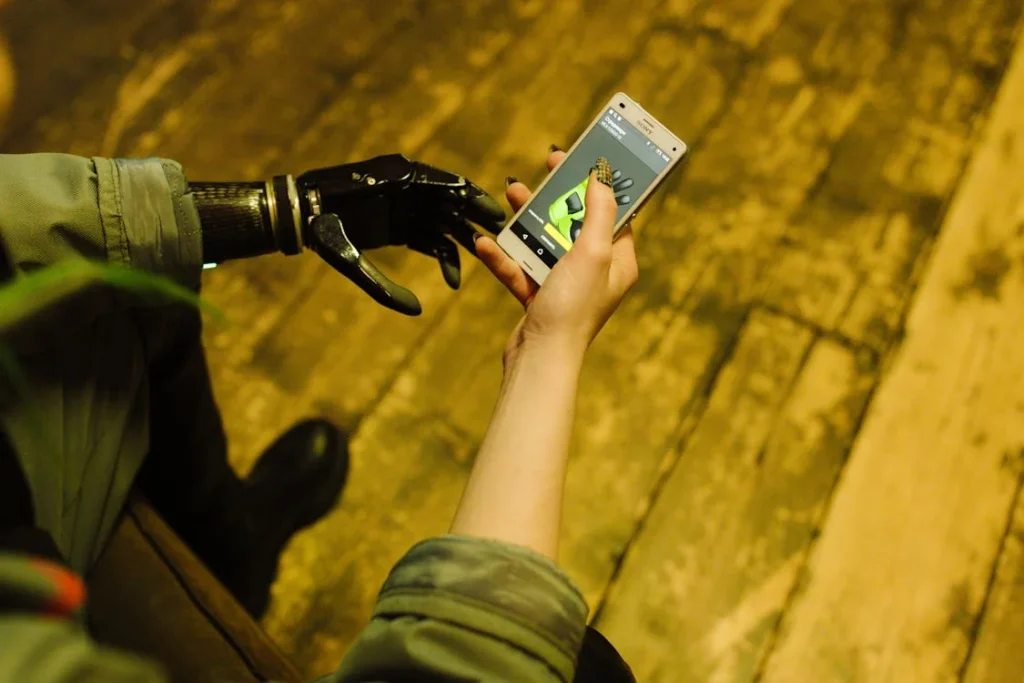Learning to use a bionic hand is a life-changing process—but it can also be a slow one. Regaining grip control takes time, patience, and a lot of practice. But let’s face it, traditional rehab routines can sometimes feel dull, repetitive, and frustrating. That’s where smart apps and gamified grip training are changing everything.
Instead of treating training like a chore, these new tools make it fun, engaging, and rewarding. Imagine powering up your grip through a video game, completing virtual tasks, or unlocking achievements just by moving your prosthetic hand. It’s no longer just about exercises. It’s about challenges. Missions. Progress. And most importantly, results that stick.
At Robobionics, we’ve seen firsthand how this shift in approach helps users feel more motivated, more confident, and more in control—right from the start.
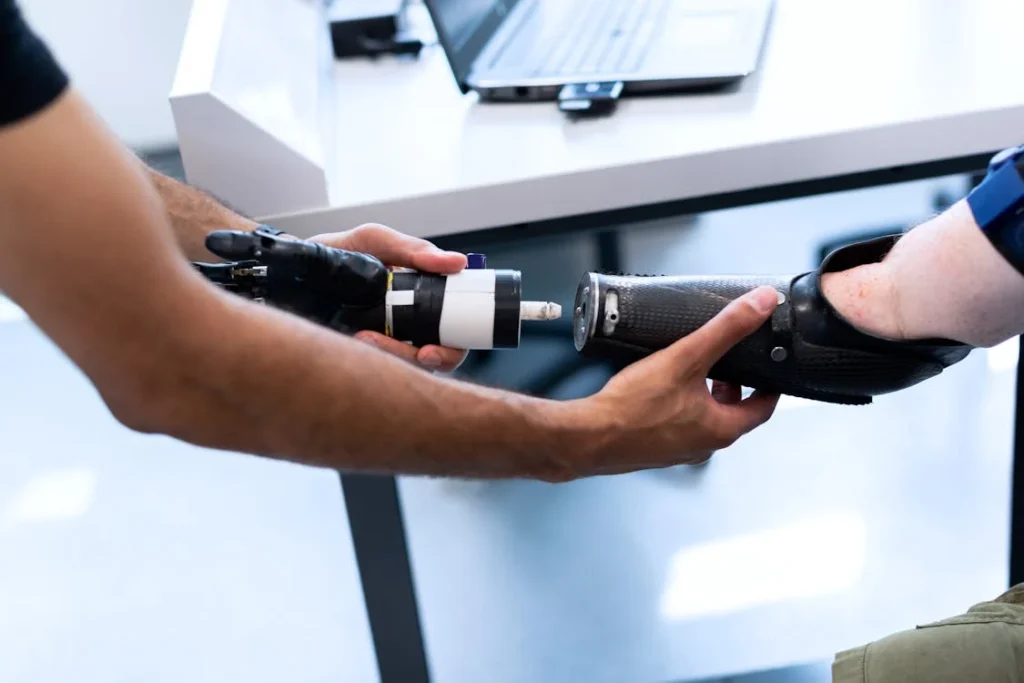
How Smart Apps Are Changing the Way We Train Grip Control
From Repetition to Real Progress
Rehabilitation after getting a bionic hand isn’t just about learning how to move—it’s about learning how to trust the movement. That trust builds slowly. At first, the signals you send from your muscles might feel unsure.
The motions might feel stiff. But over time, as you practice, something powerful starts to happen. Your brain gets better at speaking the new language of grip.
Traditional training focused on repetition. Open and close. Squeeze and release. Hold and let go. While this worked, it wasn’t always engaging. Motivation would dip. Progress could stall. And let’s be honest—when training feels boring, people are more likely to skip it or rush through it.
That’s where smart apps with gamified training systems are making a real difference.
These apps take what was once a basic, mechanical routine and turn it into something dynamic and exciting. You’re no longer just practicing a grip—you’re collecting points, unlocking levels, completing virtual tasks, or beating your own high score.
Each small motion has a purpose, and each session becomes a mission.
It feels less like therapy and more like a game. And for many users, that’s the push they need to keep going, even on the hard days.
Real-Time Feedback Builds Real Confidence
One of the most important parts of learning to use a bionic hand is getting feedback. But with traditional exercises, you don’t always know if you’re doing it right.
Did you squeeze too hard? Was your grip steady? Were you fast enough? Without clear answers, it’s easy to feel unsure or even discouraged.
Gamified apps fix that problem in a clever way.
They give instant feedback—on your grip strength, your speed, your accuracy, and your control. If you’re doing well, the app celebrates your progress.
If you slip or miss, it gently nudges you to try again. And all of it happens in real time, on-screen, with easy-to-understand visuals. You’re not just guessing anymore—you’re learning as you go.
That feedback loop creates confidence. You begin to see the small wins. You watch your scores improve. You feel the movement becoming smoother. And with every session, your control gets better without you even realizing it.
This kind of subtle, responsive guidance is what makes the training feel personal. It’s no longer a generic rehab plan. It’s your training journey, tailored to you.
Making Repetition Rewarding, Not Repetitive
Let’s be clear: progress still takes practice. There’s no magic shortcut. But what gamification does so well is make repetition feel rewarding.
Take something as simple as a pinch motion. In a traditional setup, you might be asked to repeat it 20 times in a row. That gets old quickly.
But in a gamified app, that same motion might be used to catch falling objects in a game. Or to guide a robot hand through a puzzle. Or to stack blocks without toppling them over.
Now you’re doing the exact same movement—but your mind is fully engaged. You’re focused. Invested. And most of all, entertained.
This matters. When the brain is engaged, learning is faster. The neural pathways that connect your muscle signals to your hand get stronger. Your control becomes more precise. And your grip becomes second nature.
You’re not just building strength—you’re building skill. And you’re having fun while doing it.
Training Anytime, Anywhere
Another game-changer with smart apps is accessibility. You don’t need to visit a clinic every time you want to train. With a connected prosthetic and a mobile app, you can practice from home, from your office, or even while traveling.
That kind of flexibility removes barriers. It puts power in the user’s hands—literally. You decide when to train, how often, and how hard. You can do a five-minute session before bed or a full routine after breakfast. There’s no pressure. No appointments. Just progress on your own terms.
This also means you’re more likely to stay consistent. And consistency is the secret to great grip control.
For parents of younger users, it’s especially useful. Kids can play their training games on a tablet. They get better at using their prosthetic without feeling like they’re “working” on anything.
It’s just another game on their screen—but one that’s actually rewiring their brain and strengthening their muscles in real time.
Making Progress Visible—and Shareable
Progress can feel invisible when it comes slowly. But gamified apps track every session, every win, every step forward.
You can see your progress week by week. How your grip strength has improved. How much faster your response time is. How many tasks you’ve completed. This gives you something to celebrate, something to show your family, your care team, even your community.
Some apps let you share your scores or compete with other users around the world. That small social boost can do wonders. It reminds you that you’re not alone. That others are walking the same path, facing the same challenges—and winning too.
This visibility turns grip training into something empowering. You’re not stuck in a loop of silent repetition. You’re moving forward. Leveling up. Becoming stronger, faster, more precise.
You’re not just recovering—you’re evolving.
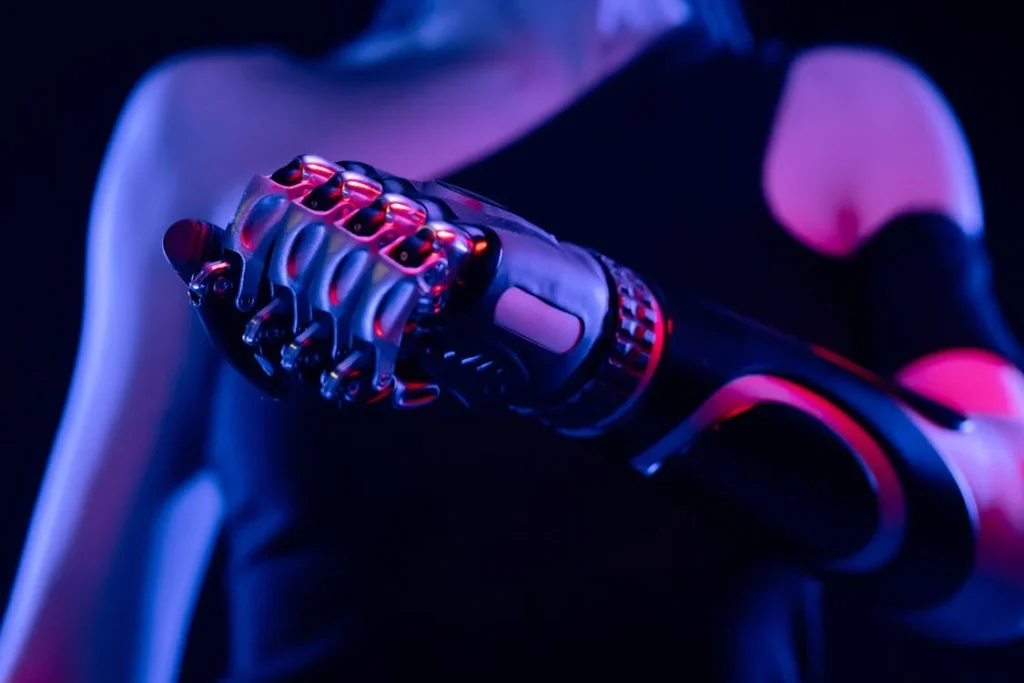
Why Gamification Works: The Science Behind Playful Progress
The Brain Learns Faster When It’s Having Fun
At first glance, it might seem like gaming and rehab don’t belong in the same sentence. One is for fun. The other is for recovery. But science tells us they’re more connected than we think—especially when it comes to motor learning and neuroplasticity.
Our brains are hardwired to pay more attention to activities that are engaging. When we’re focused, interested, or emotionally invested in what we’re doing, our brains release chemicals like dopamine, which improve motivation, memory, and learning.
This is exactly what happens during gamified grip training. You’re not just “playing”—you’re priming your brain to absorb information faster.
This matters because learning to use a bionic hand is as much a brain task as it is a physical one. Your brain has to rewire itself to control a new device through unfamiliar signals. The clearer and more consistent those signals are, the better your hand control becomes.
Gamification taps into that system beautifully. Every achievement, level-up, or high score triggers those feel-good chemicals. Every mission you complete reinforces muscle memory. Every repeated motion trains both brain and body to work together in new ways.
You’re not just practicing—you’re programming.
Clear Goals Make Movement Meaningful
One of the biggest hurdles in grip training is knowing what to aim for. In traditional therapy, the instructions might be vague: “Try to hold this object steady.” Or “work on pinch strength.” That’s helpful, but it doesn’t always provide a clear goal or sense of accomplishment.
Gamified apps solve that by giving users immediate, measurable objectives. You’re not just gripping—you’re guiding a character, hitting a target, or solving a puzzle. There’s a beginning, a challenge, and a finish line.
That clarity gives your mind something to focus on. And with each goal you meet, your confidence grows. You feel like you’re winning—because you are.
Games also adapt to your ability level. If something’s too easy, the app makes it harder. If it’s too tough, it adjusts the pace. This “adaptive difficulty” ensures you stay in the sweet spot—where you’re challenged just enough to stay motivated, but not so much that you get discouraged.
It’s a delicate balance, and it’s something traditional rehab often struggles to maintain.
Small Wins Create Big Change
One of the most powerful features of gamified grip training is the ability to celebrate small wins.
When you’re learning to use a prosthetic hand, progress can feel slow at times. You might not notice the micro-improvements—like smoother finger extension or steadier grip pressure. But these small changes are crucial. They add up.
Gamified apps are designed to notice those improvements. They track everything. And they reward you for it.
Get one percent faster? You earn points.
Hold an object without dropping it? You unlock a badge.
Complete three sessions in a row? You get a streak bonus.
These small moments of success act like fuel. They push you to keep going, even when it’s tough. They tell you, “Hey, you’re doing great. Keep at it.”
And for people recovering from injury or living with limb difference, that kind of encouragement can make all the difference.
It turns the training journey from a slow climb into an exciting, rewarding adventure. And that emotional lift is often just as important as the physical gain.
Empowering Users Through Control and Choice
Gamified grip training also puts power back where it belongs—with the user.
You get to choose when to train, how often, and which challenges to take on. You’re not waiting for a therapist or technician to tell you what to do. You’re in charge of your own progress. That kind of autonomy is hugely empowering.
It helps users feel like active participants in their recovery—not passive patients.
And because you can customize your training goals, pace, and difficulty, the experience feels personal. You’re not following a rigid plan made for everyone. You’re following a path that’s made for you.
In a world where disability can often take control away, this kind of agency is more than just helpful—it’s healing.
How Robobionics Is Using This Science
At Robobionics, we don’t just watch these trends—we help build them.
We work closely with developers, therapists, and users to create grip training systems that are backed by science but built for real life. Our focus is always on making training feel natural, rewarding, and deeply human.
We believe bionic technology shouldn’t just restore motion. It should inspire growth.
That’s why our systems are designed to be flexible, intuitive, and engaging—whether you’re just beginning your journey with a prosthetic hand or looking to sharpen advanced control.
Because when your training feels like play, progress happens faster. And when your progress feels exciting, you want to keep going.
That’s the power of smart design. That’s the future of grip training.

Designing Games That Train Your Grip: What Actually Works
It Starts with Real Movements, Not Just Fun Graphics
While the fun visuals and sound effects are what first catch your eye in a gamified training app, the real magic lies beneath the surface—in how the app is built around actual, purposeful movement.
Good grip training games don’t just give you something to look at. They’re designed with movement science in mind. That means every challenge or task in the game is crafted to activate real muscles, encourage proper control, and guide users toward more refined motor skills. The visuals just make that process more enjoyable.
Let’s say the game involves catching falling objects. You’re using a pinch grip again and again—but without even realizing it. If you’re guiding a robot through a maze, you might be practicing rotational wrist control and finger extension.
A puzzle game might help with sustained grip force and quick releases. None of it feels clinical. It all feels like play—but your brain and muscles are working hard behind the scenes.
This connection between game design and real-life hand control is what makes these apps more than just fun. They’re functional. Every level you beat strengthens your control and prepares you for real-world tasks, whether it’s zipping up a bag, slicing fruit, or typing on a screen.
The Role of Virtual Objects and Simulated Environments
One of the best things about digital training is the freedom to simulate real-world actions in creative, risk-free ways.
Virtual objects in these games behave just like real ones. They have weight, shape, and texture. They move, respond, and sometimes even break if you grip them too hard or drop them. These realistic details force your brain to calculate the right amount of force and timing to use—just like you would in real life.
This trial-and-error experience inside a safe, digital space is incredibly useful. You can make mistakes without consequence. You can repeat tasks without judgment. And you can keep refining your technique until it feels just right.
Some apps also use augmented reality (AR) to project objects into your real-world space. That means you might be looking at your own table—but placing a virtual glass on it and trying to pick it up with your prosthetic. It blends the physical and digital worlds, allowing users to transition more smoothly from training to everyday tasks.
These experiences aren’t just cool. They’re deeply practical. They make training feel relevant, which is exactly what builds long-term success.
Creating Games for Different Skill Levels
No two prosthetic users are the same. Some are new to bionics. Others have years of experience. Some are kids just learning the basics. Others are adults regaining control after trauma or surgery. That’s why good grip training apps offer layers of difficulty and flexibility.
Early levels might focus on simple movements—closing and opening the hand, holding objects for a few seconds. As users progress, the game introduces more complex tasks—multi-finger coordination, speed-based challenges, or alternating grip patterns under pressure.
This natural curve keeps users from feeling overwhelmed at the start. And it keeps them from getting bored once they’ve built confidence.
At Robobionics, we strongly believe in meeting the user where they are. Training isn’t a one-size-fits-all process. That’s why the apps we recommend or co-develop are always modular, adaptive, and adjustable to the user’s pace and goals.
Motivation That Comes from Progress, Not Pressure
Games are great at delivering motivation. Not through force or guilt—but through progress. Each small achievement, whether it’s a new high score or a badge unlocked, feels earned. It signals growth.
Unlike clinical metrics—which might feel cold or hard to interpret—game rewards are personal. They feel human. They celebrate effort, not just outcome.
Even if your hand shakes a little or your grip isn’t perfect, the game still rewards the attempt. That builds confidence. It reinforces that trying is just as important as succeeding.
And the more users feel seen and encouraged, the more they engage. The more they engage, the better their control becomes. It’s a simple cycle—but it works beautifully.
This is especially helpful for younger users, or those struggling with anxiety or low self-esteem after amputation. The right game doesn’t just teach you how to move. It teaches you to believe in what’s possible again.
From the Screen to Real-World Mastery
Here’s what’s most exciting about gamified grip training: the skills you gain in a digital space carry over into real life.
Users who’ve spent time training through apps often report that they feel more confident tackling everyday challenges. They’re more willing to try using cutlery, preparing meals, opening jars, tying shoelaces, or using touchscreens. They stop avoiding tasks. They start experimenting.
It’s not because the apps are magic—it’s because they build mental readiness alongside physical ability. Each game session isn’t just improving coordination. It’s building a mindset: I can do this. I’m getting better.
And once that mindset clicks into place, everything else becomes easier.
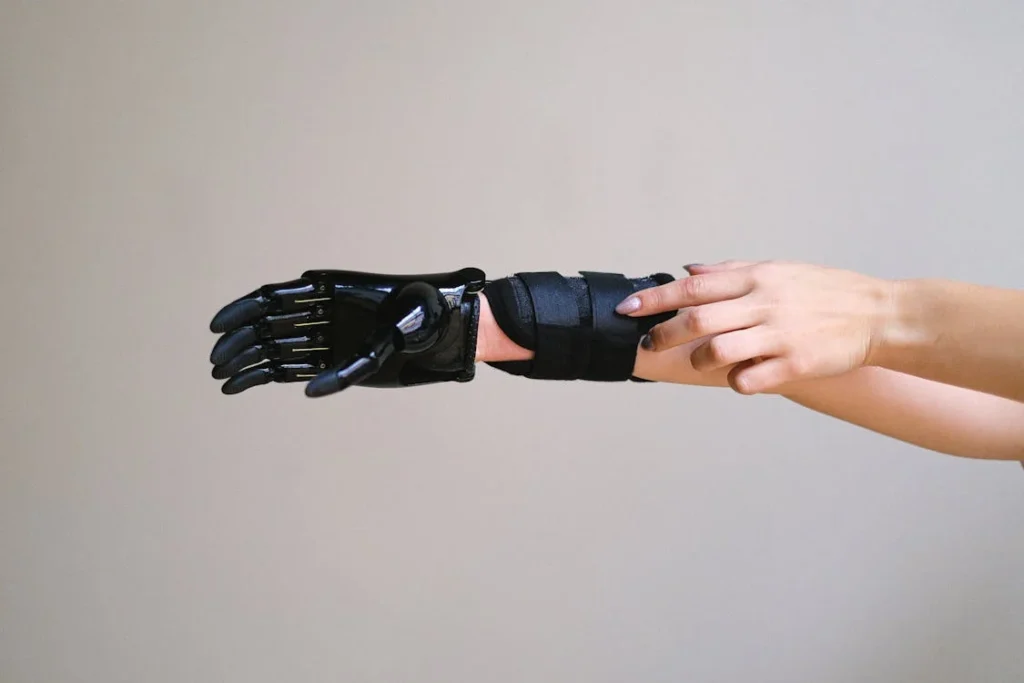
How Gamified Training Builds Long-Term Habits and Real-World Results
Training That Sticks: Turning Short Sessions Into Lifelong Skill
Building grip control is not a one-time task. It’s a journey—slow at times, sometimes frustrating, but always worth it. And like any journey, the biggest challenge is consistency. Traditional rehab programs often fail here. Users lose steam, skip sessions, or struggle to stay motivated.
Gamified grip training solves that by making practice something you look forward to.
It’s much easier to commit to a five- or ten-minute session when it feels like a game. And when that game responds to your effort—cheers your wins, shows your progress, and encourages you to keep going—it becomes a habit. And habits, once formed, are what lead to long-term success.
This is where gamified training really shines. It turns learning into routine. Instead of needing to be pushed or reminded, users return to the app naturally. It becomes part of their day. A quick session before breakfast. A high score attempt before bed. Over time, these small, fun moments lead to real improvement in hand control, speed, and coordination.
At Robobionics, we see this every day with our users. The ones who use gamified systems regularly tend to show faster recovery, stronger grip performance, and—most importantly—more confidence in their day-to-day lives.
Creating a Feedback Loop That Grows With You
One of the smartest things about grip training apps is how they grow alongside the user. The more you use them, the more they learn about your strengths and weaknesses.
If you tend to struggle with grip release, the app will gently introduce tasks that help you practice that. If your precision is strong, it’ll give you tasks that test speed or multi-finger coordination.
This personalized feedback loop is incredibly powerful.
It’s not like traditional rehab, where you might follow the same worksheet or drill week after week. With smart apps, each session adapts based on your performance. That means you’re always training in your “challenge zone”—where the difficulty pushes you forward without overwhelming you.
This balance is what keeps users engaged. They feel seen. They feel supported. And they feel challenged in just the right way.
Seeing the Results in Real Life: What Users Tell Us
We often hear from users who say things like:
“I used to avoid picking up small things like coins or pins—but now I do it without thinking.”
“I’ve started helping out more in the kitchen. Chopping, holding bowls, cleaning. It feels natural again.”
“My child started using his bionic hand more at school. He says it’s fun now, not frustrating.”
These aren’t just emotional wins—they’re functional breakthroughs. And they don’t happen in isolation. They’re the result of daily, low-pressure practice made possible by gamified apps.
This kind of spillover from digital training to real-life confidence is what makes these systems so exciting. You’re not just leveling up in a game—you’re leveling up in life.
You’re tying shoelaces without second-guessing. You’re holding hands more comfortably. You’re returning to work tasks with better focus and control. The line between training and living begins to blur—in the best possible way.
Reducing the Fear of Failure
For many users, especially those new to bionic hands, there’s a real fear of failure. What if I drop something? What if I can’t grip properly in public? What if I mess up and someone notices?
This fear can hold people back. It leads to hesitation, to relying too much on the other hand, to avoiding certain tasks altogether.
Gamified grip training helps chip away at that fear. Because in a game, you’re allowed to fail. And then you try again. And again. Until it gets easier.
This permission to fail safely—and without judgment—is key. It creates an emotional space where users can experiment, push their limits, and build skill without fear. That sense of psychological safety is hard to replicate in traditional training, but it’s built right into gamified systems.
And once a user becomes comfortable failing and trying again digitally, that confidence starts to show up in the real world too.
Suddenly, trying something new—like brushing hair, tying an apron, or holding a phone—isn’t scary anymore. It’s just another challenge. One you’re ready for.
Community and Shared Motivation
Another beautiful outcome of gamified apps is that they can connect users to each other.
Some apps allow for shared leaderboards, progress badges, or friendly competitions. Others build small online communities where users can share wins, swap tips, or just cheer each other on.
This sense of connection and shared motivation is powerful. It reminds people that they’re not alone. That others are walking the same path, facing the same challenges, and celebrating the same small victories.
And for people recovering from injury or dealing with the emotional weight of limb loss, that sense of belonging can be just as important as the training itself.
At Robobionics, we always encourage users to stay connected—whether through a therapist, a peer group, or even an online challenge inside an app. Because recovery isn’t just about hand control. It’s about heart. And community helps both.
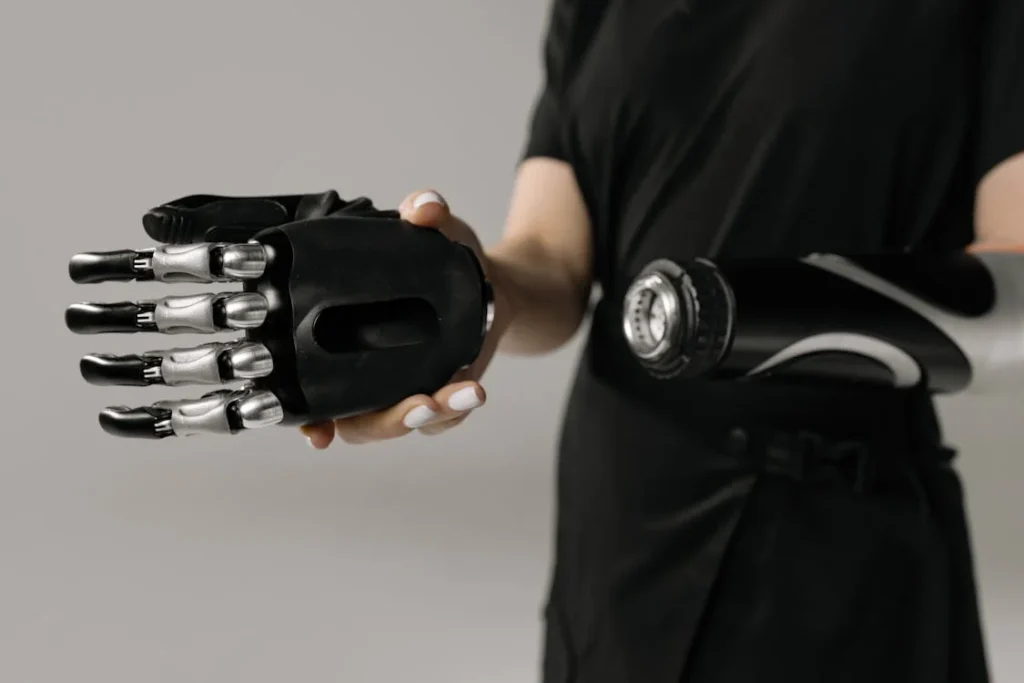
Rehabilitation for the Next Generation: How Gamified Training Is Shaping Prosthetic Use in Children and Teens
Why Early Engagement Matters More Than Ever
When a child or teenager receives a bionic hand, the road ahead looks very different than it does for an adult. Young users aren’t just learning to use their prosthetic—they’re learning how to grow with it.
Their muscles, coordination, and cognitive skills are still developing. And their emotional response to limb difference is deeply tied to their experiences in school, at home, and with friends.
This is where gamified grip training becomes not just helpful—but essential.
Traditional rehab for younger users can feel slow or frustrating. Repeating basic grip motions can seem boring. And for many kids, if something isn’t interesting or interactive, it simply doesn’t stick. That’s where smart apps shine.
They introduce grip training in a language kids already understand—games. Whether it’s catching digital apples, controlling a cartoon character, or racing through obstacles using their prosthetic, children are far more engaged when play is part of the process.
And that engagement leads to faster learning, better muscle control, and—most importantly—positive emotional reinforcement.
Building a Sense of Ownership and Identity
Another major advantage of gamified apps for younger users is that they create a sense of ownership over the training experience. Instead of being told what to do by a therapist or a parent, the child becomes the player. They take charge. They choose the level. They control the avatar.
This shift in perspective helps build confidence and pride in using the prosthetic. Kids stop seeing it as something foreign or awkward—and start seeing it as part of who they are. A tool. A superpower. Something they can control.
Some apps even allow kids to customize how their digital hand looks in the game. Whether they choose colors, skins, or character outfits, this kind of personalization strengthens the emotional bond between the user and the device. It tells the child: this is yours. And that sense of identity carries into daily life, helping reduce self-consciousness and build resilience.
Fostering Focus and Patience Through Gameplay
Children and teens can struggle with focus—especially when something is difficult or doesn’t provide quick feedback. Traditional rehab often doesn’t meet them where they are developmentally.
But games do.
By offering immediate responses to each motion and using progressive difficulty levels, gamified grip training teaches patience and concentration without it feeling forced. When the goal is clear and achievable—like stacking blocks in a game or unlocking a badge—kids are more likely to stick with it. Even if they fail a few times, the game encourages them to keep trying.
This playful persistence translates beautifully to real-life prosthetic use. Children who train through games often show more mental endurance in learning harder tasks—like writing, using scissors, or dressing themselves.
Supporting Parents and Teachers Along the Way
Grip training doesn’t happen in a vacuum. For young users, it often involves parents, teachers, and therapists—all working together to guide the child toward success. But not every adult has the time or training to assist with daily prosthetic exercises.
Smart apps make this process easier for everyone.
Many come with tracking dashboards that show how often the child is practicing, how well they’re doing, and which areas need improvement. Parents can monitor progress without micromanaging. Teachers can get a clearer picture of the child’s development. And therapists can use the data to design more effective, personalized treatment plans.
The result? A more unified and supportive care environment. One that doesn’t rely on guesswork, but on real, usable information.
A Healthier Relationship with Tech
It’s no secret that kids today spend a lot of time on screens. But with the right kind of app, that screen time can become productive, not passive. Instead of endless scrolling or mindless games, they’re learning, training, and growing.
Gamified grip training helps children build a healthier relationship with both their device and technology in general. It teaches them that tech can be a tool for empowerment, for creativity, and for mastery—not just entertainment.
And for young prosthetic users, that’s a powerful message: you’re not limited by your difference—you’re enhanced by your tools.
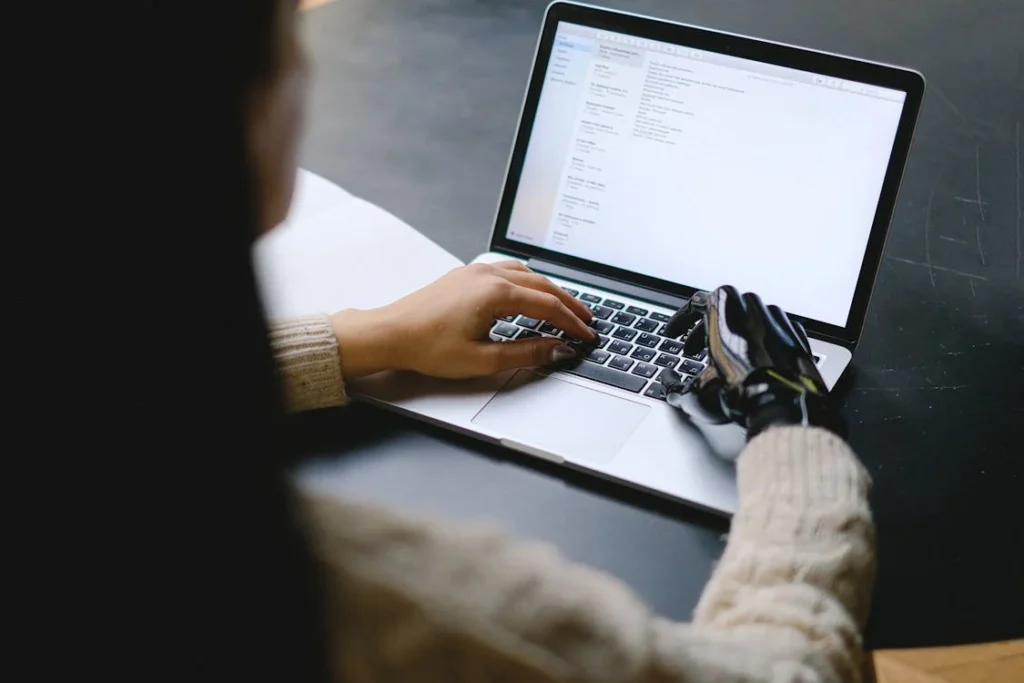
From Clinic to Companion: How Professionals Are Using Gamified Grip Training to Guide and Personalize Care
Shifting the Role of the Therapist from Instructor to Strategist
In the past, prosthetic training was heavily therapist-led. The clinician would prescribe a set of exercises, monitor repetition, and offer hands-on feedback during in-person sessions. While this model worked, it relied entirely on in-clinic time. Users often struggled between appointments, and progress could stall without immediate guidance.
Gamified grip training is flipping that script.
Now, clinicians don’t have to be present for every repetition or correction. Instead, they can analyze real-time data from a user’s training app to understand where they’re excelling and where they’re stuck.
They become strategists, not just instructors—crafting smarter, more focused care plans that build on what the user is already doing at home.
By using game data like grip duration, strength, release timing, and frequency of training, professionals can see patterns that were previously invisible. They can spot subtle coordination issues, muscle fatigue, or even emotional avoidance based on user behavior. That insight leads to smarter, faster interventions—without more clinic visits.
Remote Monitoring and Better Continuity of Care
One of the biggest challenges in prosthetic rehabilitation is maintaining progress between visits. Life gets busy. Travel to clinics can be difficult. And even the most motivated users sometimes fall off track without accountability.
Smart apps solve this by acting as a digital extension of the clinic. They allow therapists to stay connected to their users from anywhere.
With remote dashboards and user reports, professionals can monitor training in real time. If a user hasn’t trained in a few days, they can send a gentle reminder. If performance dips suddenly, they can schedule a quick check-in. It’s not about surveillance—it’s about support.
This continuity of care is especially valuable in rural or underserved areas, where access to in-person prosthetic services may be limited. A user in a small town can now receive the same personalized coaching and feedback as someone in a major metro—just by logging into an app.
And for prosthetic manufacturers like us at Robobionics, this opens up huge possibilities. We’re building tools that not only empower the user, but make life easier for the care team supporting them.
Tracking Outcomes More Accurately and Objectively
Before gamified tools, most grip training outcomes were tracked manually. Therapists would rely on logs, worksheets, or subjective observation. While valuable, this method lacked consistency—and left a lot of gray area when it came to measuring real-world performance.
Now, with app-based tracking, therapists get clear, objective data. They can measure how often the user trains, what types of grips they use, and how their performance changes over time. There’s no need to rely on memory or estimation. The data speaks for itself.
This also helps when it comes to reporting outcomes to insurance providers or funding bodies. With hard numbers showing steady progress or consistent training, users can more easily qualify for continued support, device upgrades, or additional services.
It also gives therapists a chance to prove the value of their work in measurable terms—a growing need in today’s healthcare landscape.
Turning Data Into Dialogue
The best part about this kind of data? It leads to better conversations.
Instead of therapists asking, “How has your training been going?” they can now say, “I saw your grip control improved by 12% this month. What do you think helped most?” Or, “You’ve been avoiding the pinch grip levels in the app—what’s making that one tough?”
These conversations are richer. More precise. More collaborative.
They help users feel heard and understood. And they allow therapists to do their job with greater clarity, focus, and empathy.
In many ways, the app becomes a translator between user and professional—a bridge that helps both sides speak the same language, even outside of the clinic.
Enhancing Device Fittings and Adjustments
Another exciting application of gamified data is during prosthetic fitting and fine-tuning.
Sometimes, a user might feel like something’s off with their device—but can’t quite explain it. Maybe the grip feels weak. Maybe certain movements don’t come as easily as others. Maybe their timing seems just a little slow.
By reviewing data from their training sessions, the prosthetist can pinpoint the issue faster. Maybe the socket needs a small adjustment. Maybe a sensor needs to be repositioned. Or maybe the user’s training goals need to shift based on what the data is showing.
This kind of precision care was much harder to deliver before. Now, it’s built into the training process itself.
At Robobionics, we’re actively working on systems that allow prosthetists and therapists to interface directly with user apps—not just to view data, but to send tailored exercises or challenges that meet each user’s evolving needs.
It’s care that doesn’t end at the clinic door. It travels with the user, wherever they go.
Conclusion
Gamified grip training is more than a trend—it’s a breakthrough in how we help bionic hand users build skill, strength, and confidence. By turning repetitive exercises into fun, interactive challenges, these smart apps make daily practice feel less like work and more like play. The result? Better hand control, faster learning, and deeper motivation.
But the benefits go far beyond the screen. Users gain independence. Therapists gain insight. And prosthetists can fine-tune care with real-world data that drives real results. Whether you’re a child learning your first grip or an adult fine-tuning your control, gamified training meets you where you are—and helps you grow from there.
At Robobionics, we believe technology should empower, not overwhelm. And with every tap, swipe, and challenge completed, these tools are helping users do more than just train their hands—they’re reclaiming control of their lives.
Grip training will never be the same. And that’s a good thing.



